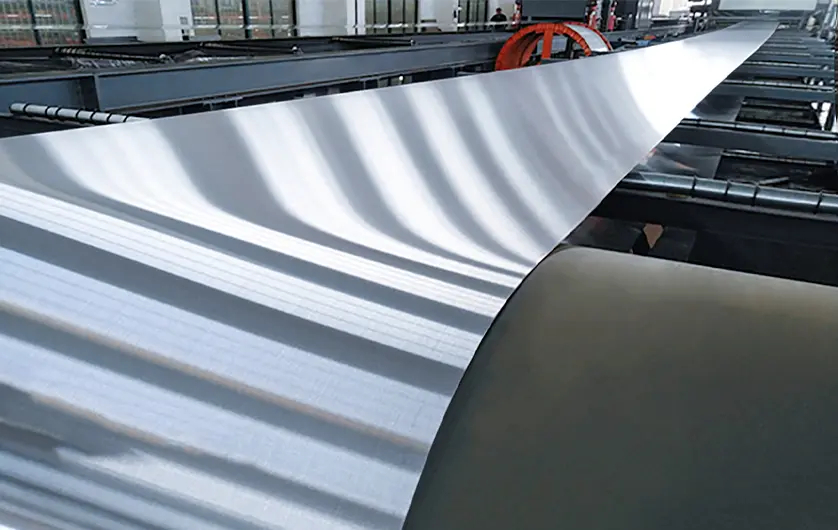Martensitic Stainless Steel vs Austenitic Stainless Steel
Martensitic Stainless Steel:-
The production of martensitic stainless steel starts with the formation of martensite. The creation of body-centered crystalline iron is known as “martensite”, and it takes the shape of a solid. Most martensitic stainless steels are shaped by heating austenite to a high temperature and then rapidly cooling it to a relatively low temperature. The method under consideration is referred to as mitigation. Cementite formation can be avoided if the material is cooled quickly enough. This technique removes any extra carbon atoms in the material and unusually locks them away. It gives martensitic stainless steel a very high level of abrasion resistance and a very high level of hardness. The material’s microstructure contributes to its abrasion resistance, and carbon is responsible for its hardness.
Stainless Steel is Manufacture and export by BMI, a steel manufacturing company that uses high quality raw material. Bhansali Metalloys Inc is leading manufacturer, supplier, dealer and exporter of all types of stainless steel in different sizes, dimensions and grades. Bhansali Metalloys Inc also provide specially designed stainless steel as per the requirements and specifications of the customers. Our Stainless Steel is offered in created to order length sizes and shapes, and are obtainable at market leading costs.
What are Martensitic stainless steels used for?
Martensitic stainless steels are used when corrosion resistance and/or oxidation resistance are required in combination with either high strength at low temperatures or creep resistance at elevated temperatures.


Austenitic Stainless Steel:-
Austenitic stainless steel is an alloy with excellent corrosion resistance and special mechanical properties. This alloy’s basic crystal structure is a face-centered cubic structure, and its “austenite” component may be found in it. The corrosion resistance of martensitic stainless steels is lower than austenitic stainless steels; however, martensitic stainless steels have greater strength, abrasion resistance, and toughness than austenitic stainless steel steels.
Applications that require significant wear and tear handling, such as platforms, transportation, abrasive surfaces, and so on, choose materials with these qualities because of their durability. The material’s inflexibility must also be high to ensure the structure does not bend under relatively light pressures.
What Are the Characteristics of an Austenitic Stainless Steel?
Austenitic stainless steel has many positive characteristics driving demand; this category makes up approximately three-quarters of the global stainless steel market, which was valued at $93.69 billion in 2018 and is expected to show a CAGR of 5.2 percent by 2025.
Strength at Temperature: Austenitic stainless steel can withstand extreme temperatures degrees, depending upon the grade up to approximately 1900F. Some grades start to see some deforming, softening, or loss of strength at 800 degrees Fahrenheit.
Cold Workability: Austenitic Stainless Steels cannot be hardened via heat treatment. Only cold working or reduction can increase the strength of austenitic. Cold working refers to shaping a metal without heating it, which can be done with austenitic stainless steel. Austenitic stainless steels can be annealed before rapidly cooling or “quenching” the metal to bring it back to its original state. Cold rolled stainless steel comes with several advantages: improved surface finish which is beneficial because a steel with an improved surface finish will have a higher hardness which resists crack propagation, and improved strength.
Low Thermal Conductivity: Heat transfers slowly through austenitic stainless steel. Ferritic stainless steel, on the other hand, has higher thermal conductivity.
Formability: Austenitic stainless steel is highly formable, making it especially versatile for a wide variety of applications.


Cold working austenitic stainless steel increases its strength and decreases its ductility. Of course, different stainless steels have advantages in different applications, as well. Austenitic stainless steel is more susceptible to stress corrosion cracking than ferritic.
Austenitic stainless steel is usually not magnetic, while ferritic stainless steel usually is magnetic. You may have wondered why some refrigerators are magnetic while others are not: it’s because they’re made of different stainless steels.
We say these are each “usually” the way they are because there are exceptions. Certain processes or temperatures can cause the crystal structure to rearrange, giving the material magnetic properties.
Each Stainless Steel is otherwise designed based on the characteristics of the applying and additionally the pressure. Consequently, different industries use different Stainless Steel. We also produce customized Stainless Steel Products at our factory as per our client’s requirements. For any types of Stainless Steel Grade Price List Call on +91 9152160158 or drop an Email to infobmi32@gmail.com | exportbmi32@gmail.com
We Export Across the Globe
Exports in Asia Afghanistan, Armenia, Azerbaijan, Bangladesh, Bhutan, Brunei Darussalam, Cambodia, China, Georgia, Hong Kong, India, Indonesia, Japan, Kazakhstan, South Korea, Kyrgyzstan, Laos, Macao, Malaysia, Maldives, Mongolia, Myanmar (ex-Burma), Nepal, Pakistan, Phillipines, Singapore, Sri Lanka (ex-Ceilan), Taiwan, Tajikistan, Thailand, Timor Leste (West), Turkmenistan, Uzbekistan, Vietnam.
Export to Africa Burundi, Comoros, Djibouti, Eritrea, Ethiopia, Kenya, Madagascar, Malawi, Mauritius, Mayotte, Mozambique, Reunion, Rwanda, Seychelles, Somalia, Tanzania, United Republic of Uganda, Zambia, Zimbabwe, Angola, Cameroon, Central African Republic, Chad, Congo (Brazzaville), Congo, Democratic Republic of the Equatorial Guinea, Gabon, Sao Tome and Principe, Algeria, Egypt, Libyan Arab Jamahiriya, Morroco, South Sudan, Sudan, Tunisia, Western Sahara, Botswana, Lesotho, Namibia, South Africa, Swaziland, Benin, Burkina Faso, Cape Verde, Cote d’Ivoire (Ivory Coast), Gambia, Ghana, Guinea, Guinea-Bissau, Liberia, Mali, Mauritania, Niger, Nigeria, Saint Helena, Senegal, Sierra Leone, Togo.
Export to America Anguilla, Antigua and Barbuda, Aruba, Bahamas, Barbados, Bonaire, Saint Eustatius and Saba, British Virgin Islands, Cayman Islands, Cuba, Curaçao, Dominica, Dominican Republic, Grenada, Guadeloupe, Haiti, Jamaica, Martinique, Monserrat, Puerto Rico, Saint-Barthélemy, St. Kitts and Nevis, Saint Lucia, Saint Martin, Saint Vincent and the Grenadines, Sint Maarten, Trinidad and Tobago, Turks and Caicos Islands, Virgin Islands (US), Belize, Costa Rica, El Salvador, Guatemala, Honduras, Mexico, Nicaragua, Panama, Argentina, Bolivia, Brazil, Chile, Colombia, Ecuador, Falkland Islands (Malvinas), French Guiana, Guyana, Paraguay, Peru, Suriname, Uruguay, Venezuela, Bermuda, Canada, Greenland, Saint Pierre and Miquelon, United States.
Export to the Middle East Bahrain, Iraq, Iran, Israel, Jordan, Kuwait, Lebanon, Oman, Palestine, Qatar, Saudi Arabia, Syria, United Arab Emirates, Yemen.




